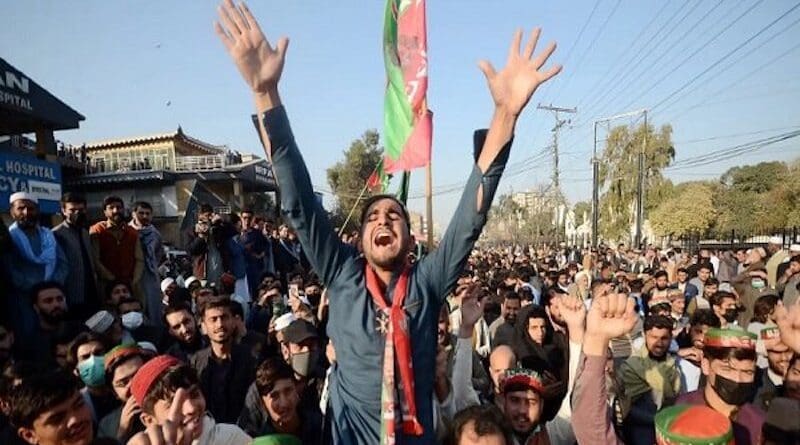Pakistan Elections: An Explainer – Analysis
By IPCS
By Muneer Ahmed
None of the three main political parties in Pakistan were able to secure a majority in parliament following the 8 February election. Of the 266 contestable National Assembly (NA) seats, independent candidates backed by Imran Khan’s Pakistan Tehreek-e-Insaf (PTI) won 93. Nawaz Sharif’s Pakistan Muslim League (Nawaz) (PML-N) and Bhutto-Zardari’s Pakistan People’s Party (PPP) secured 75 and 54 seats, respectively.
Plagued by the army’s relentless intermingling, these elections delivered two dominant conclusions. One, Imran Khan appears large in Pakistani politics even while languishing in jail, and two, after failing to counter Imran’s popularity, his rivals, Nawaz Sharif and Bilawal Bhutto Zardari, have been forced to form a coalition government, readying the country for another round of instability.
Why Imran Looms So Large
For decades, Pakistan’s government has been an army-run game of musical chairs between the PML-N and PPP, both led by two dynasties. Imran Khan’s PTI managed to create a niche for itself during the 2018 elections. Imran was unseated in April 2022 by a no-confidence motion brought by the opposition, with the support of the army.
The initial fault lines between Imran Khan and the military leadership occurred over a dispute related to the transfer of an Inter-Services Intelligence (ISI) officer. Imran, however, didn’t step down quietly, and indirectly accused Gen. Bajwa for his unceremonious ouster. In May 2023, Khan openly blamedthe new Army Chief Asim Munir for orchestrating his arrest. Imran’s allegations were seen as plausible, as he was arrested in the High Court by the Pakistan Rangers, who operate under the Interior Ministry and are commanded by officers on secondment from the army.
Imran’s arrest triggered protests across the country. Demonstrators set fire to a corps commander’s home in Lahore and attacked army headquarters (GHQ) in Rawalpindi. Such public outrage against the army was expressed for the first time in Pakistan’s history. These elections proved to be a medium for many Pakistani voters to express their discontent with the army and institutions that were acting under its influence. The primary grievance was that these shadowy institutions attempted to rob the voters of their choice, and campaigners were denied a level playing field. Despite being banned from the elections, denied their political ‘bat’ symbol, constant crackdowns on members, and campaigning amidst fears of arrest, PTI-backed independents secured 93 seats. These recent election results, therefore, can be read as a huge setback for the army and its meddling in political affairs.
A Fragile Alliance of Former Foes
With no party in majority, Pakistan has inevitably moved towards a six-party alliance government led by the PML-N and PPP. Shehbaz Sharif will be prime minister, and important appointments will be split between several parties. With a total of 152 general seats, the bloc is likely to cross the majority mark of 169 after the allocation of reserved seats. There are 70 seats reserved for women and minorities that are shared proportionately among parties represented in the National Assembly (NA). PML-N, PPP, and other parties had previously shared power for 16 months, until August 2023, under the aegis of the Pakistan Democratic Movement (PDM), with Shehbaz Sharif lading the government and Bilawal Bhutto Zardari as foreign minister.
This alliance shouldn’t come as a surprise. Gen. Asim Munir backed former Prime Minister Nawaz Sharif’s appeal to his opponents to assist in forming a coalition government since the general elections have resulted in a hung parliament. Under the leadership of a ‘compliant’ Shehbaz Sharif, the army seems to have achieved its aim of installing a weak coalition government. There are, however, a few ground realities that the army appears to have overlooked, especially since Imran’s ouster. One, Imran Khan continues to be the most popular leader in Pakistan. Two, the PDM government’s rating fell as they struggled to control inflation and a faltering economy during its previous tenure. Three, the six-party coalition appears to be an uneasy gathering of former foes. The two leading parties of the alliance, PML-N and PPP, have a history of bitter rivalry. They staunchly opposed each other up until the recent polling, with a senior PPP leader calling his party’s participation in the 16-month-long power-sharing PDM, a mistake.
Meanwhile, the PTI is readying itself to create obstacles for the coalition government. PTI-backed candidates are working to create an alliance with the religious parties. The ‘ineligible’ PTI seeks a share of reserved seats using another party’s banner. There is no clarity in Section 104 of the Election Act, 2017 to indicate if PTI-backed members will be able to obtain reserved category seats merely by joining smaller parties. Under this clause, nomination lists had to be submitted to the Election Commission (EC) by 22 December 2023. Nonetheless, even the reserved seats won’t bring the party to power as they will still be short of the 169 mark. The PTI independents are, however, set to create a strong opposition that will have massive popular support. While the PTI was threatening to move the Supreme Court against ‘rigged’ polls, the Rawalpindi Commissioner admitted his involvement and accused the EC and the Chief Justice of election rigging.
Another Round of Instability?
This election outcome has sent a strong public signal about the army establishment’s persistent political interference. To add insult to the army’s injury, the results have further bolstered Imran Khan’s popular image. For now, the PML-N and PPP, despite trailing PTI-backed candidates, have been able to muster a coalition with the army’s blessing. Imran might attempt to use popular support to further fuel anti-establishment sentiment—thus sending strained civil-military ties further down a slippery slope. What methods the military chooses to demonstrate—and re-establish—de facto leadership from this point on remains to be seen.
- About the author: Muneer Ahmed is Senior Researcher with IPCS’ Centre for Internal and Regional Security (IReS).
- Source: This article was published by IPCS

